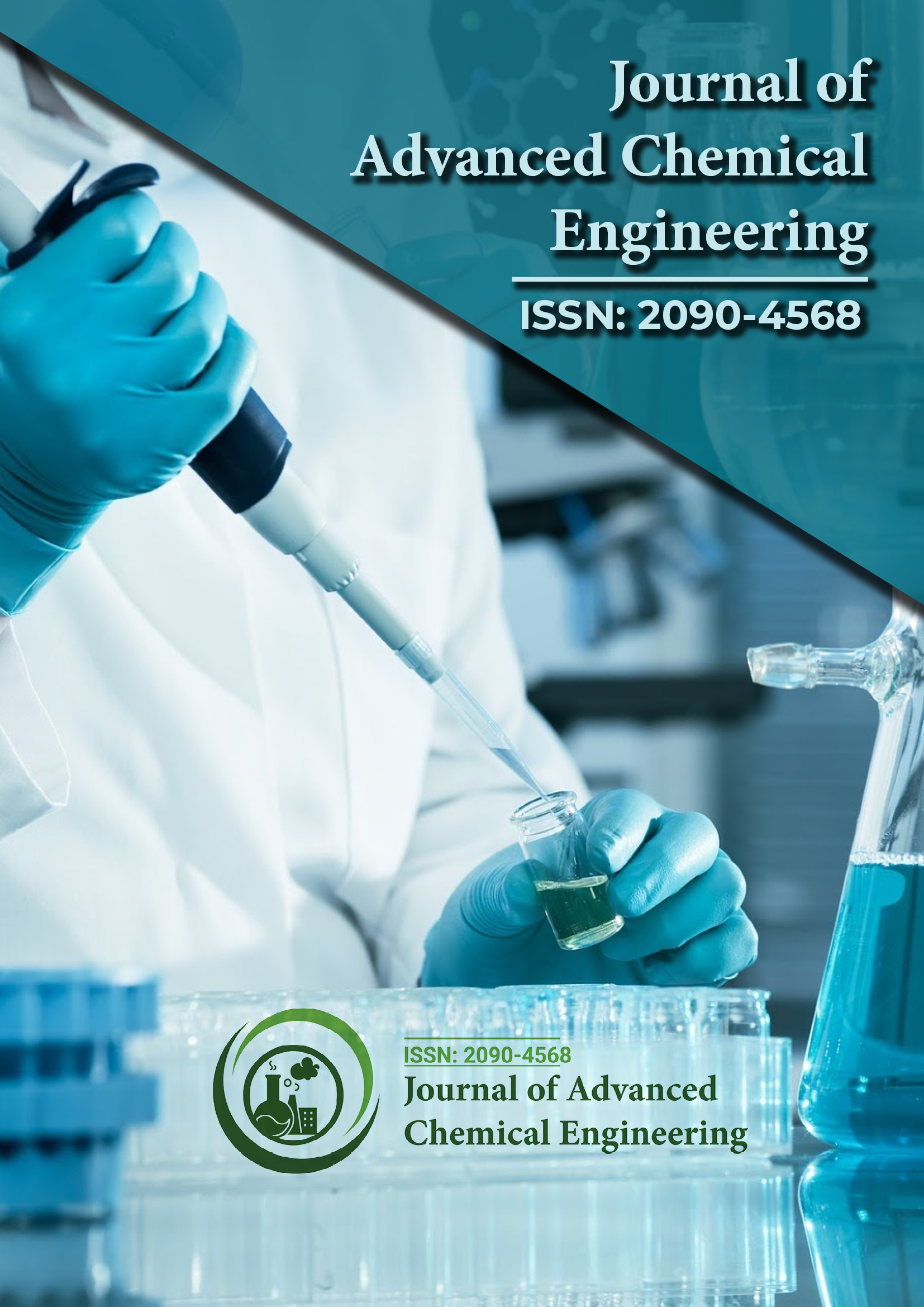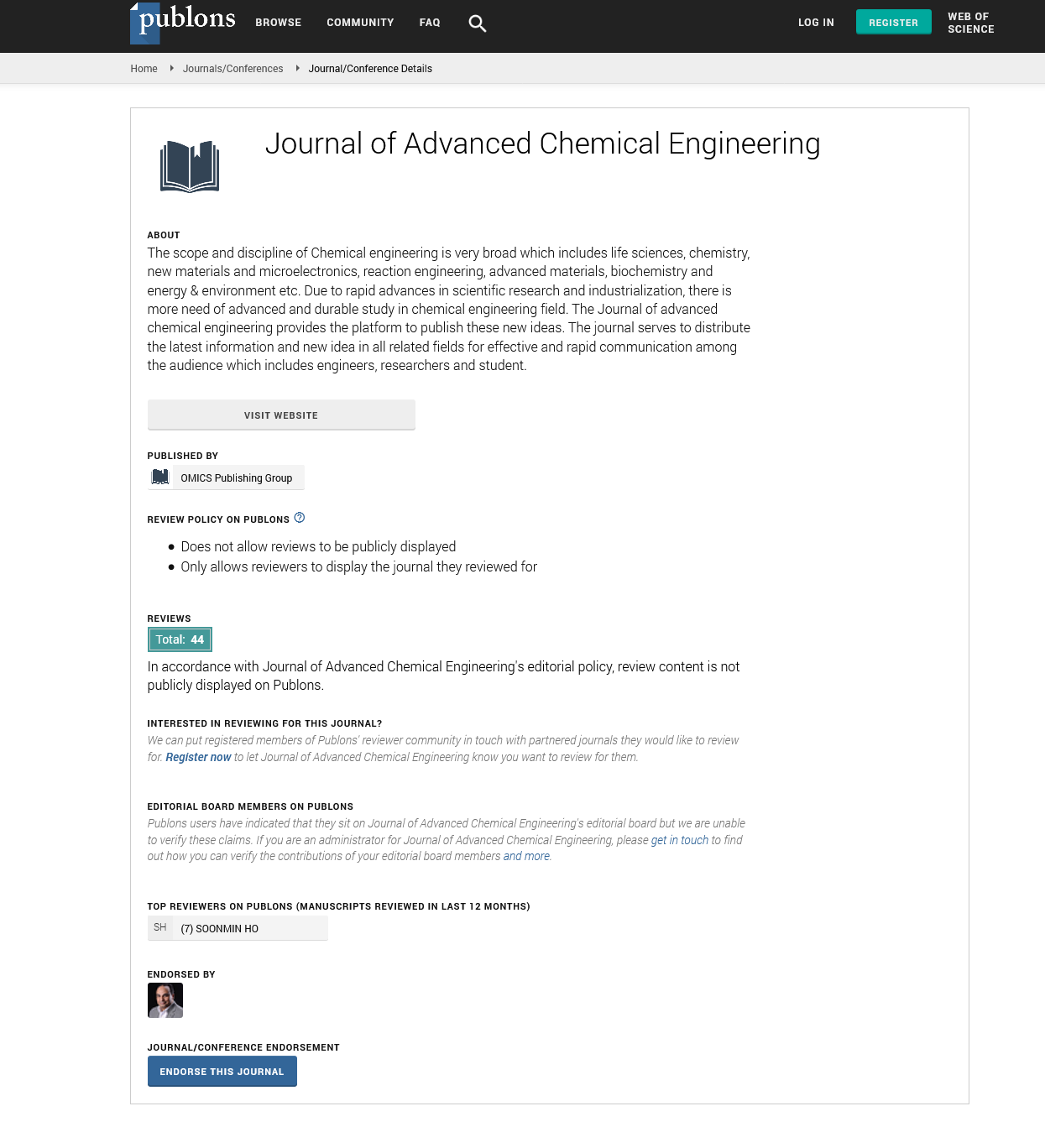Indexed In
- Open J Gate
- Genamics JournalSeek
- Smithers Rapra
- RefSeek
- Directory of Research Journal Indexing (DRJI)
- Hamdard University
- EBSCO A-Z
- OCLC- WorldCat
- Scholarsteer
- Publons
- Geneva Foundation for Medical Education and Research
- Google Scholar
Useful Links
Share This Page
Journal Flyer

Open Access Journals
- Agri and Aquaculture
- Biochemistry
- Bioinformatics & Systems Biology
- Business & Management
- Chemistry
- Clinical Sciences
- Engineering
- Food & Nutrition
- General Science
- Genetics & Molecular Biology
- Immunology & Microbiology
- Medical Sciences
- Neuroscience & Psychology
- Nursing & Health Care
- Pharmaceutical Sciences
Perspective - (2024) Volume 14, Issue 2
Role of Near-Plasma Chemical Surface Engineering in Minimizing Dust Contamination
Wei Qian*Received: 20-May-2024, Manuscript No. ACE-24-26620 ; Editor assigned: 22-May-2024, Pre QC No. ACE-24-26620 (PQ); Reviewed: 05-Jun-2024, QC No. ACE-24-26620 ; Revised: 12-Jun-2024, Manuscript No. ACE-24-26620 (R); Published: 19-Jun-2024, DOI: 10.35248/2090-4568.24.14.335
Description
Dust contamination is a significant challenge in various industries, particularly in electronics manufacturing, pharma- ceuticals, and food processing. Even minute amounts of dust can lead to product defects, reduced efficiency, and safety hazards. To address these issues, innovative approaches are being explored to enhance surface cleanliness and prevent dust accumulation. One such method is near-plasma chemical surface engineering, a technique that potential solutions for minimizing dust contamination.
Near-plasma chemical surface engineering
Near-plasma chemical surface engineering involves the use of plasma technology to modify the surfaces of materials. Unlike traditional plasma processes that operate in a full plasma state, near-plasma techniques work in a slightly different regime, allowing for fine-tuned surface modifications. This approach involves the creation of reactive species in a low-pressure environment close to the surface, which interact with the material to enhance its properties.
Principles of near-plasma technology: Near-plasma technology operates under conditions where a partially ionized gas or plasma interacts with the surface. This technique generates reactive species, such as ions, radicals, and photons, which can chemically modify the surface of materials. These reactive species can lead to the deposition of thin coatings or the alteration of surface properties to make them more resistant to dust accumulation.
Surface modification mechanisms: Near-plasma processes can modify surfaces through various mechanisms, including etching, deposition, and chemical activation. By adjusting parameters such as gas composition, pressure, and power, engineers can control the type and extent of surface modification. This flexibility allows for precise tailoring of surface characteristics to minimize dust adherence.
Mechanisms to prevent dust contamination
Near-plasma chemical surface engineering offers several mechanisms to reduce or prevent dust contamination on surfaces. Each mechanism addresses different aspects of dust management, from surface energy to material properties.
Surface energy reduction: One of the primary ways to prevent dust accumulation is by reducing the surface energy of the material. Near-plasma treatments can modify surface chemistry to lower surface energy, making it less attractive for dust particles. For example, applying a low-energy coating can create a surface that repels dust, reducing the likelihood of particles sticking.
Surface roughness control: Surface roughness plays a significant role in dust adhesion. By using near-plasma techniques to modify surface roughness, it is possible to create smoother surfaces that are less prone to dust accumulation. Fine-tuning the roughness at a microscopic level can prevent dust from settling and sticking to the surface.
Anti-static treatment: Dust particles are often attracted to surfaces due to static charges. Near-plasma treatments can be used to impart anti-static properties to materials, reducing their tendency to attract dust. By neutralizing static charges, these treatments can significantly decrease dust accumulation and improve surface cleanliness.
Applications in various industries
The application of near-plasma chemical surface engineering extends across multiple industries where dust contamination poses significant challenges. Each industry benefits from tailored solutions that enhance surface performance and reduce dust- related issues.
Electronics manufacturing: In electronics manufacturing, dust contamination can lead to defects in microelectronic components and assemblies. Near-plasma surface engineering can be used to create ultra-clean surfaces and protective coatings for sensitive electronic parts. This ensures higher reliability and performance of electronic devices.
Pharmaceuticals: The pharmaceutical industry requires strict control over environmental contamination to ensure the quality and safety of products. Near-plasma techniques are employed to prevent dust contamination in cleanrooms and production areas. Surface modifications help maintain sterile conditions and prevent cross-contamination.
Food processing: In food processing, dust contamination can affect product quality and safety. Near-plasma surface engineering is used to create surfaces that are easy to clean and resistant to dust accumulation. This contributes to a more hygienic production environment and reduces the risk of contamination.
Advantages of near-plasma chemical surface engineering
Near-plasma chemical surface engineering offers several advantages over traditional methods for managing dust contamination. These benefits include enhanced precision, versatility, and efficiency.
Precision control: Near-plasma techniques allow for precise control over surface modifications, enabling the creation of specific surface properties tailored to prevent dust contamination. This precision ensures that surfaces meet the exact requirements for different applications.
Versatility: The flexibility of near-plasma processes makes them suitable for a wide range of materials and applications. Whether modifying metals, polymers, or ceramics, near-plasma technology can be adapted to address dust contamination issues across various industries.
Efficiency: Near-plasma treatments are typically efficient and can be integrated into existing manufacturing processes. The ability to modify surfaces quickly and effectively helps reduce production downtime and operational costs.
Challenges and future directions
While near-plasma chemical surface engineering offers numerous benefits, there are also challenges and areas for further development.
Cost considerations: Implementing near-plasma technology can involve significant initial investment, including equipment and process development costs. Research into cost-effective solutions and scalable technologies is essential for broader adoption.
Process optimization: Fine-tuning near-plasma processes for specific applications requires ongoing research and optimization. Developing standardized protocols and methods for various materials and environments will enhance the effectiveness of near-plasma treatments.
Long-term durability: Assessing the long-term durability of near- plasma modifications is important for applications where surfaces are exposed to harsh conditions. Research into the longevity and stability of surface treatments will ensure their continued effectiveness.
Citation: Qian W (2024) Role of Near-Plasma Chemical Surface Engineering in Minimizing Dust Contamination. Adv Chem Eng. 14.335.
Copyright: © 2024 Qian W. This is an open-access article distributed under the terms of the Creative Commons Attribution License, which permits unrestricted use, distribution, and reproduction in any medium, provided the original author and source are credited.

